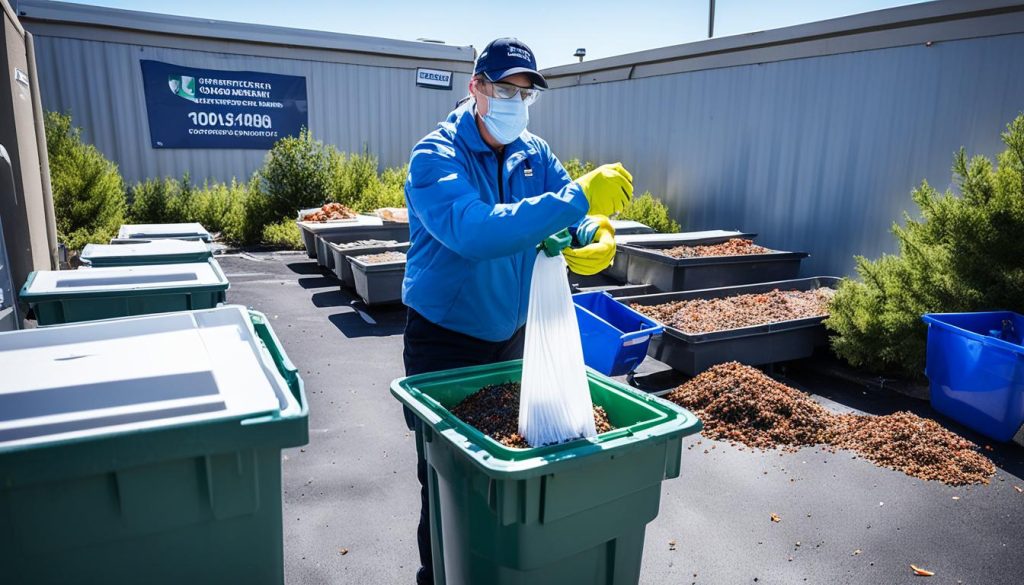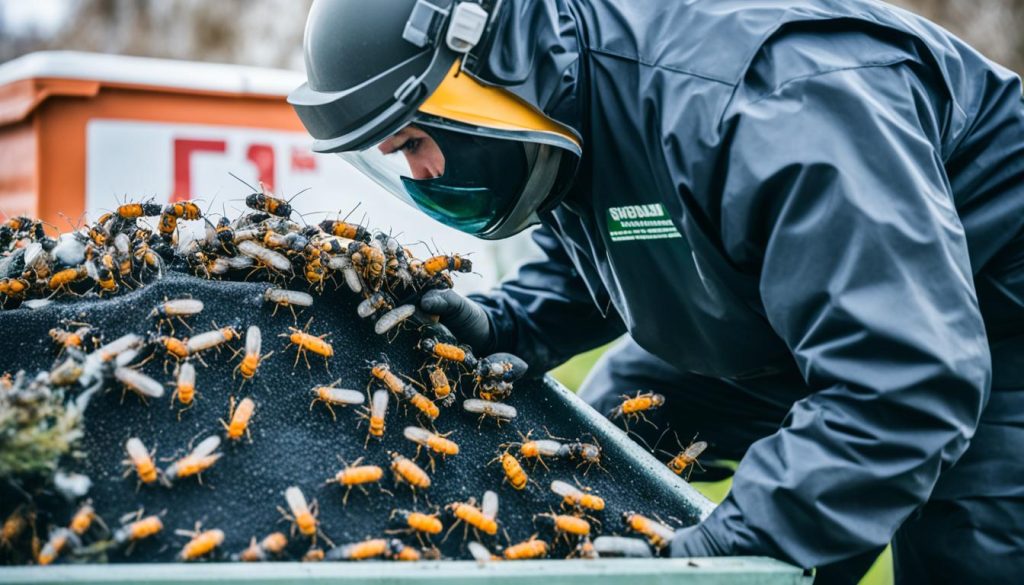In the pursuit of maintaining stellar food safety standards, food workers are often the frontline defense in deterring pests from outdoor dumpsters. By employing strategic preventative measures, the risk of pest invasions can be significantly curtailed. However, addressing such challenges extends beyond mere reactionary tactics — food workers must recognize that thorough waste management, rigorous sanitation protocols, and comprehensive staff training are integral to keeping these unwelcome visitors at bay.
Key Takeaways
- Food workers’ role in implementing pest-deterring strategies is crucial for food safety.
- Effective waste management is pivotal in minimizing risks of pest contamination.
- Sanitation protocols help eliminate potential food and shelter sources for pests.
- Regular training is key for staff to understand and uphold pest prevention measures.
- Maintaining cleanliness around dumpsters deters pests and ensures hygienic surroundings.
Implementing Integrated Pest Management (IPM) Techniques
Integrated Pest Management (IPM) represents a cornerstone in maintaining a hygienic environment within the food industry, focusing on sustainable prevention practices and minimal pesticide use. A key starting point is educating on blocking entry points, which includes a rigorous examination of infrastructure to ensure pests are kept at bay. Parallel to structural safeguards are sanitation protocols that ensure potential feeding and nesting grounds for pests are eradicated. Lastly, none of these measures are effective without the foundational support provided by ongoing staff training, keeping everyone informed and proactive about pest control.
Blocking Entry Points to Prevent Pest Access
By identifying and blocking entry points, businesses can significantly reduce the likelihood of pest infestations. Methods include thorough checks for cracks and crevices, installing door sweeps, and reinforcing any gaps that offer access to pests. Preventative action is the first defense against potential infestations and part of a robust IPM strategy.
Sanitation Protocols to Remove Food and Shelter Sources
Effective sanitation protocols are integral to IPM, as they remove the vital components pests seek: food and shelter. Regular cleaning schedules, immediate waste disposal, and storage practices that eliminate pest harboring-locations are important aspects. By removing these attractants through diligent sanitation, the incentive for pests to enter and remain in the facility is substantially diminished.
Continuous Staff Training on Pest Prevention Measures
Staff training serves as the human element in IPM, with education on pest identification, understanding the importance of reporting signs of infestation, and responding appropriately to a pest presence. Continuous training keeps the staff up-to-date with the latest IPM tactics, reinforcing the facility’s overall pest deterrence capabilities.
Strengthening Dumpster Defense Strategies
In the fight against pests, crafting robust dumpster defense strategies is essential for every food service facility. Not only do these practices help in securing waste containers effectively, but they also reinforce the importance of maintaining cleanliness and isolating dumpsters through various barrier systems.
Securing Waste Containers with Lids and Locks
To keep pests at bay, securing waste containers is the first line of defense. Employing sturdy lids and reliable locking mechanisms ensures that trash remains inaccessible to unwanted visitors. This tactic is a cornerstone of dumpster defense strategies, creating a solid barrier between pests and waste materials.
Maintaining Cleanliness in Waste Disposal Areas
A crucial aspect of pest management is maintaining cleanliness in areas where waste is disposed. Regular cleaning schedules, immediate spill management, and disciplined waste segregation are all aspects of a holistic approach to reducing pest attraction and safeguarding the vicinity from infestations.
Isolating Dumpsters and Implementing Barrier Systems
Isolating dumpsters from immediate access by pests can be achieved through the implementation of barrier systems. Controlled access points, fences, and concrete pads are all effective ways to discourage pests from encroaching on waste disposal sites, thereby reinforcing the integrity of the overall sanitation effort.

Monitoring and Collaborative Approaches for Ongoing Prevention
The cornerstone of any successful pest management program is diligent monitoring, a task that requires meticulous attention to detail and regular assessments. For food service establishments, ongoing prevention is far more than a one-time initiative—it’s a continuous commitment to excellence in health and safety standards. Regular inspections serve as a pulse check on the health of outdoor dumpsters, providing invaluable data that can spotlight the early warning signs of pest invasion. By proactively identifying these harbingers of potential problems, businesses can adopt responsive measures to avert the full brunt of pest infestations.
However, the task of safeguarding the perimeters around dumpsters isn’t a solitary fight; it calls for collaborative approaches that weave together the strengths of multiple stakeholders. Engaging with professional pest control operators, environmental management agencies, and even the local community lays the foundation for broad-based defense strategies against pests. Such alliances not only bolster preventive endeavors through shared expertise and resources but also foster a culture of collective vigilance that’s essential for continuous pest prevention. The synergy from these collaborations equips food workers with a comprehensive toolkit that meshes industry-leading practices with local insights.
In conclusion, maintaining a pest-free zone around outdoor dumpsters necessitates a vigilant approach to ongoing prevention, underscored by rigorous monitoring and dynamic collaborations. It is the tapestry of these efforts, meticulously woven together, that upholds the integrity of our food establishments, ensuring that they stand as bastions of hygiene and safety in our communities. Persistent in their vigil, food workers and collaborators alike play a pivotal role in this unending endeavor, fortifying their establishments against unwelcome pests and their detrimental effects.


